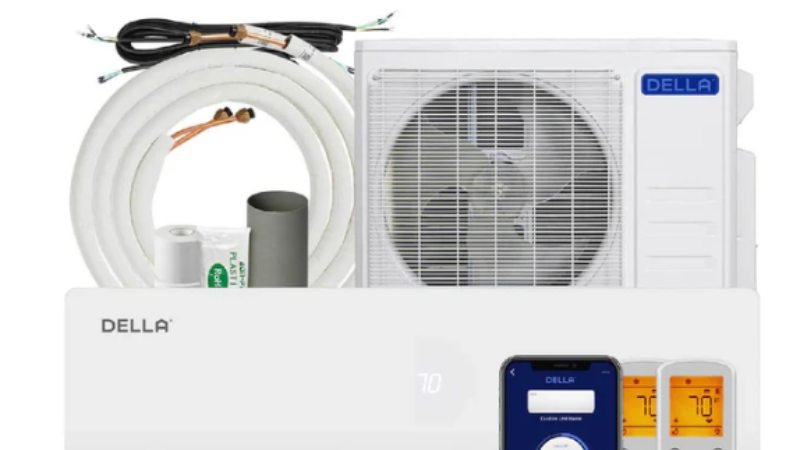- Mini-split air conditioners have become increasingly popular for homeowners and businesses seeking efficient heating and cooling solutions. Offering flexibility and customization, these systems come in various configurations, such as mini split three zone and dual head mini split models. However, like any HVAC system, mini-splits come with their own set of advantages and disadvantages. This article will explore the pros and cons of mini-split air conditioners to help you make an informed decision.
Understanding Mini-Split Air Conditioners
A mini-split air conditioner consists of two main components: an indoor unit and an outdoor unit. Unlike traditional central air conditioning systems, mini-splits operate without ductwork, allowing for easy installation in various settings. They are available in multiple zones, meaning one outdoor unit can power several indoor units, each capable of being controlled independently. This zoning capability is a significant selling point for many consumers.
Pros of Mini-Split Air Conditioners
- Energy Efficiency
Mini-split systems are known for their energy efficiency, particularly when compared to traditional HVAC systems. Many mini-splits have high SEER (Seasonal Energy Efficiency Ratio) ratings, which indicates they can provide significant cooling while consuming less electricity. This efficiency can lead to lower energy bills over time.- Inverter Technology: Many modern mini-splits feature inverter technology, allowing the compressor to adjust its speed based on the cooling or heating demand. This not only enhances energy efficiency but also provides a more consistent temperature.
- Zoning Capabilities
One of the standout features of mini-split systems is their ability to create zones within a home or office. A mini-split three-zone system can control different areas independently, allowing occupants to set their preferred temperatures in each space. This customization leads to increased comfort and energy savings, as you only heat or cool areas that are in use. - Flexible Installation Options
Mini-split air conditioners are versatile in their installation options. The indoor units can be wall-mounted, ceiling-mounted, or even floor-mounted, providing flexibility in design. This feature is especially beneficial for homes that lack existing ductwork or where traditional systems would be impractical. - Reduced Noise Levels
Mini-split systems are generally quieter than traditional central air conditioning systems. The indoor units operate at low noise levels, making them suitable for bedrooms, offices, and other quiet spaces. This can enhance comfort, especially during sleep or work hours. - Year-Round Comfort
Many mini-split systems provide both cooling and heating functions, making them versatile for year-round use. Inverter-driven mini-splits can efficiently extract heat from the outside air during winter, providing an effective heating solution in colder climates. - Improved Indoor Air Quality
Mini-split systems often come equipped with advanced filtration systems that can improve indoor air quality by removing dust, allergens, and pollutants. This is particularly beneficial for individuals with allergies or respiratory issues. - Lower Installation Costs
The installation of mini-split systems can be less invasive and more straightforward than traditional ducted systems. There’s no need for ductwork, which can significantly reduce installation costs and time. Many mini-split systems can be installed within a few hours, depending on the complexity of the setup.
Cons of Mini-Split Air Conditioners
- Higher Initial Cost
While mini-splits can save you money on energy bills, the initial cost of purchasing and installing a mini-split system can be higher than traditional HVAC systems. This cost may vary based on the number of zones, the type of indoor units, and installation requirements.- Budget Considerations: Homeowners should consider their budget when deciding whether to invest in a mini-split system. While they offer long-term savings, the upfront investment can be substantial.
- Aesthetic Considerations
Some homeowners find that the appearance of the indoor units detracts from their decor. While many mini-splits have sleek designs, the visible indoor units may not blend seamlessly with all interior styles. In contrast, traditional ducted systems are typically hidden from view. - Regular Maintenance Required
Like any HVAC system, mini-splits require regular maintenance to operate efficiently. This includes cleaning or replacing filters, checking refrigerant levels, and ensuring proper drainage. While maintenance can often be performed by homeowners, some tasks may require professional assistance, leading to additional costs. - Potential for Reduced Efficiency in Extreme Temperatures
While mini-splits are efficient, their performance can be affected by extreme outdoor temperatures. In very cold conditions, the heating capacity may decrease, making it less effective for heating larger spaces. In such cases, supplemental heating may be necessary. - Limited Range of Cooling Capacity
While mini-splits come in various sizes and configurations, their capacity may be limited compared to central air conditioning systems. For larger homes or spaces, multiple units may be required, which can increase costs and complexity. - Installation Challenges
Although installation is generally straightforward, it can still pose challenges, especially for complex setups involving multiple indoor units. Homeowners should ensure that the installation is performed by qualified professionals to avoid issues related to improper installation, such as refrigerant leaks or inefficiencies. - Possible Refrigerant Leaks
Mini-split systems use refrigerants to transfer heat. If the system develops a leak, it can lead to decreased efficiency and environmental concerns. While professional maintenance can help detect leaks early, homeowners should be vigilant about monitoring their systems.
Conclusion
Mini-split air conditioners, including dual zone mini split and multi zone mini split systems, offer a range of benefits, including energy efficiency, zoning capabilities, and flexible installation options. However, they also come with potential drawbacks, such as higher initial costs and aesthetic considerations. By understanding the pros and cons of mini-split systems, homeowners can make informed decisions about their heating and cooling needs.
Investing in a mini-split system can lead to significant long-term savings and improved comfort when chosen correctly. Whether you are considering a dual-zone setup for specific areas of your home or a multi-zone system for comprehensive coverage, careful evaluation of your needs and preferences will ensure that you select the best solution for your living space. Is this article helpful? Keep reading our blog for more Kaz Magazine.
- Energy Efficiency
